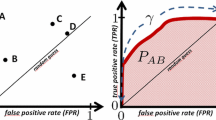Abstract
Prototype-based classification is mainly influenced by the family of learning vector quantizers (LVQ) as introduced by Kohonen. The main goal is to optimize the classification accuracy while the prototypes explore the class distribution in the data space. Recent variants can deal also with dissimilarity data, i.e. only the dissimilarities between the data objects are given. Otherwise, classification accuracy may be not appropriate to judge the classification performance, for example for imbalanced data or in medical applications, where frequently sensitivity and specificity are favored. In this paper we develop a median LVQ-variant optimizing those statistical classification evaluation measures, if only dissimilarity data are available. Thus, the presented approach is the discrete counterpart of a recently proposed LVQ-approach for optimization of statistical measures in case of vectorial data. For this purpose, we make use of a probabilistic description of the classification decision proposed in Robust Soft LVQ.
Access this chapter
Tax calculation will be finalised at checkout
Purchases are for personal use only
Similar content being viewed by others
Notes
- 1.
For a mathematical definition of a dissimilarity measure we refer to [20].
References
Blake, C., Merz, C.: UCI repository of machine learning databases. University of California, Department of Information and Computer Science, Irvine, CA. http://www.ics.edu/mlearn/MLRepository.html (1998)
Cottrell, M., Hammer, B., Hasenfu, A., Villmann, T.: Batch and median neural gas. Neural Netw. 19, 762–771 (2006)
Fawcett, T.: An introduction to ROC analysis. Pattern Recogn. Lett. 27, 861–874 (2006)
Geweniger, T., Fischer, L., Kaden, M., Lange, M., Villmann, T.: Clustering by fuzzy neural gas and evaluation of fuzzy clusters. Comput. Intell. Neurosci. 2013, Article ID 165248 (2013). doi:10.1155/2013/165248
Hammer, B., Hasenfuss, A.: Topographic mapping of large dissimilarity data sets. Neural Comput. 22(9), 2229–2284 (2010)
Hammer, B., Hofmann, D., Schleif, F.-M., Zhu, X.: Learning vector quantization for (dis-)similarities. Neurocomputing, page in press (2013)
Hathaway, R., Bezdek, J.: NERF c-means: non-Euclidean relational fuzzy clustering. Pattern Recogn. 27(3), 429–437 (1994)
Hathaway, R., Davenport, J., Bezdek, J.: Relational duals of the c-means clustering algorithms. Pattern Recogn. 22(3), 205–212 (1989)
Hermann, W., Barthel, H., Hesse, S., Grahmann, F., Kühn, H.-J., Wagner, A., Villmann, T.: Comparison of clinical types of Wilson’s disease and glucose metabolism in extrapyramidal motor brain regions. J. Neurol. 249(7), 896–901 (2002)
Jaccard, P.: The distribution of the flora in the alpine zone. New Phytol. 11, 37–50 (1912)
Kaden, M., Hermann, W., Villmann, T.: Optimization of general statistical accuracy measures for classification based on learning vector quantization. In: Verleysen, M. (ed.) Proceedings of European Symposium on Artificial Neural Networks, Computational Intelligence and Machine Learning (ESANN’2014), pp. 47–52, Louvain-La-Neuve, Belgium (2014). i6doc.com
Kaden, M., Lange, M., Nebel, D., Riedel, M., Geweniger, T., Villmann, T.: Aspects in classification learning—Review of recent developments in Learning Vector Quantization. Found. Comput. Decis. Sci. 39(2), 79–105 (2014)
Kohonen, T.: Learning vector quantization for pattern recognition. Report TKK-F-A601, Helsinki University of Technology, Espoo, Finland (1986)
Kohonen, T.: Self-Organizing Maps. Springer Series in Information Sciences, vol. 30. Springer, Berlin, Heidelberg (1995)
Matthews, B.: Comparison of the predicted and observed secondary structure of T4 phage Iysozyme. Biochimica et Biophysica Acta 405, 442–451 (1975)
Nebel, D., Hammer, B., Frohberg, K., Villmann, T.: Median variants of learning vector quantization for learning of dissimilarity data. Neurocomputing 169, 295–305 (2015)
Nebel, D., Hammer, B., Villmann, T.: Supervised generative models for learning dissimilarity data. In: Verleysen, M. (ed.) Proceedings of European Symposium on Artificial Neural Networks, Computational Intelligence and Machine Learning (ESANN’2014), pp. 35–40, Louvain-La-Neuve, Belgium (2014). i6doc.com
Nebel, D., Villmann, T.: A median variant of generalized learning vector quantization. In: Lee, M., Hirose, A., Hou, Z.-G., Kil, R. (eds.) Proceedings of International Conference on Neural Information Processing (ICONIP). LNCS, vol. II, pp. 19–26. Springer-Verlag, Berlin (2013)
Nova, D., Estévez, P.: A review of learning vector quantization classifiers. Neural Comput. Appl. (2013)
Pekalska, E., Duin, R.: The Dissimilarity Representation for Pattern Recognition: Foundations and Applications. World Scientific (2006)
Rijsbergen, C.: Information Retrieval, 2nd edn. Butterworths, London (1979)
Rogers, D.J., Tanimoto, T.: A computer program for classifying plants. Science 132(3434), 1115–1118 (1960)
Sato, A., Yamada, K.: Generalized learning vector quantization. In: Touretzky, D.S., Mozer, M.C., Hasselmo, M.E. (eds.) Advances in Neural Information Processing Systems 8. Proceedings of the 1995 Conference, pp. 423–429. MIT Press, Cambridge, MA, USA (1996)
Seo, S., Obermayer, K.: Soft learning vector quantization. Neural Comput. 15, 1589–1604 (2003)
Author information
Authors and Affiliations
Corresponding author
Editor information
Editors and Affiliations
Rights and permissions
Copyright information
© 2016 Springer International Publishing Switzerland
About this paper
Cite this paper
Nebel, D., Villmann, T. (2016). Optimization of Statistical Evaluation Measures for Classification by Median Learning Vector Quantization. In: Merényi, E., Mendenhall, M., O'Driscoll, P. (eds) Advances in Self-Organizing Maps and Learning Vector Quantization. Advances in Intelligent Systems and Computing, vol 428. Springer, Cham. https://doi.org/10.1007/978-3-319-28518-4_25
Download citation
DOI: https://doi.org/10.1007/978-3-319-28518-4_25
Published:
Publisher Name: Springer, Cham
Print ISBN: 978-3-319-28517-7
Online ISBN: 978-3-319-28518-4
eBook Packages: EngineeringEngineering (R0)




